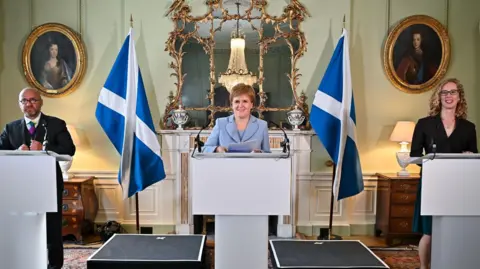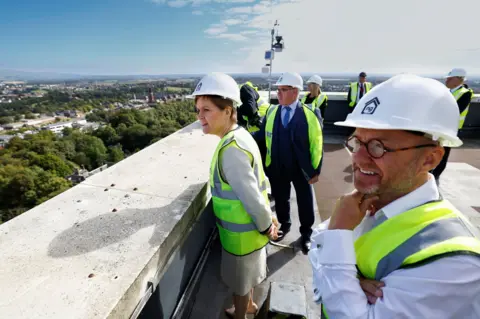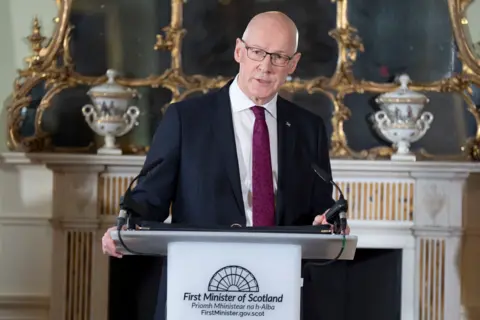How did the SNP-Green relationship go so wrong?
 PA Media
PA MediaThe Scottish government has dropped plans for a new national park in Dumfries and Galloway - the latest in a series of policies driven by the Scottish Greens to have been scrapped by the SNP.
The idea was originally taken forward by Lorna Slater, when she was a government minister under the Bute House Agreement between the two parties.
But since she and Green co-leader Patrick Harvie were kicked out of their ministerial offices by Humza Yousaf, the majority of policies included in the pact have been binned.
From marine protection areas to climate targets, changes how homes are heated and a ban on conversion therapy, the agreed programme has mostly been torn up.
Was the partnership worth it, looking back? And where does it leave the SNP and Greens heading into next year's Holyrood election?
 PA Media
PA MediaThings have changed enormously in Scottish politics since Nicola Sturgeon brought the Greens into government in 2021.
She departed Bute House in 2023, and her successor Humza Yousaf barely lasted a year as first minister.
Ultimately, it was his decision to end the Bute House Agreement (BHA) which ended his tenure.
A big motivation for the SNP in going into the pact was that it would provide stability against votes of no confidence, so it was somewhat fitting that the threat of such a vote forced Mr Yousaf out of office days after he ended the deal.
John Swinney has since taken the administration off in a different direction with Kate Forbes as his deputy.
The decision on the Galloway national park is just the latest in a procession of policies which underpinned the partnership to have been consigned to history.
Let's take a look through the original agreement documents to check on the fate of some others.
Changing climate measures
Cracks had started to appear in the pact prior to Mr Yousaf's decision to end it, particularly when the government announced it was dropping its climate targets.
The BHA had called for a "credible pathway" to hitting the admittedly ambitious 2030 interim target for cutting carbon emissions.
But after watchdogs underlined that this was looking increasingly unlikely, the government decided to do away with the interim goals and move to a system of carbon budgets.
That wasn't the last climate measure to be scrapped either, with ministers also conceding that a target of reducing car use by 20% by 2030 wasn't going to happen.
Another bone of contention at the time was Mr Yousaf's abrupt announcement of a council tax freeze - something the Greens opposed.
Indeed the original agreement was that there would be a citizen's assembly on council tax reform.
This has never materialised, and the longstanding promises to change how local taxation works have been kicked off into the next parliamentary term (again).
 PA Media
PA MediaOne of the biggest pieces of work the Greens undertook in government was Patrick Harvie's heat in buildings bill, which aimed to move more homes to greener systems like heat pumps rather than boilers.
The bill was shelved earlier this year after acting net zero secretary Gillian Martin said it would "make people poorer", voicing concerns that it could increase fuel poverty.
A revised version of the bill has since been published, but it stops short of a legal requirement to replace heating systems by 2045.
'Watered down'
Mr Harvie was also the minister for tenant's rights, with the Greens central to plans to cap rents and ban evictions during the cost of living crisis.
But the party takes a fairly dim view of the "watered down" system of rent controls currently being considered in the Housing (Scotland) Bill, saying they are not nearly strong enough.
Another proposed bill was the ban on conversion therapy, which the Greens remain keen on - but which SNP ministers would really rather the UK government deal with.
The decision to kick that into the next parliamentary term compounded the rift over gender reforms, which the two parties had cooperated over while passing the Gender Recognition Reform Bill in 2022.
But Mr Yousaf decided to drop legal challenges to defend the legislation after it was blocked by the UK government, and Mr Swinney's administration have been clear that they will not be bringing it back.
Ending the headaches
These policies follow a pattern of the Swinney government being happy to drop particularly controversial policies.
Why spend political capital defending something that was someone else's priority in the first place?
The same thing happened with a plan to designate 10% of Scotland's waters as highly protected marine areas, which sparked opposition in coastal communities.
In fairness, a few things had been delivered before the Greens left government.
The new National Planning Framework had been finalised, including the BHA requirements for 20 minute neighbourhoods and greater priority for onshore wind developments.
However, it should be noted that Green hopes for an energy strategy which would support offshore wind and marine renewables remain unrealised, given Mr Swinney's government still hasn't published its long-awaited energy strategy.
 PA Media
PA MediaThe Scottish government also boosted the Scottish Child Payment, something enshrined in the agreement - although given it is a flagship policy for the SNP, it is likely that would have happened anyway.
The same could probably be said of the £500m just transition fund for the North East and Moray, given it was in the SNP manifesto.
Other successes included the Fair Work First guidance, which requires public sector bodies which get government grants to pay the real living wage, and a pledge to replace the Scottish Qualifications Authority.
A National Register of Ancient Woodlands is being produced, with a target date of 2027, and the promised Natural Environment Bill – aimed at improving biodiversity - has been tabled.
These do feel like relatively small wins, though, compared to what was promised and ultimately abandoned.
'Totemic policy'
The decision to end the partnership agreement couldn't have been much more damaging for Humza Yousaf, given he ended up quitting.
It has had consequences for the party's broader policy platform too though.
The SNP had also been relying on Green support for one of its flagship policies for the term, the National Care Service.
The BHA committed the parties to driving forward what it called a "totemic policy", but the Greens eventually joined other opposition parties in rallying against the proposal put down on paper by ministers.
A vote at the party's conference went overwhelmingly against the proposal, underlining that it could not make it through parliament - although it was already clear by then that it would be undeliverable in any case, given opposition from key partners like unions, councils and health boards.
The future
Looking back over the wreckage of the Bute House Agreement may be instructive when we think ahead to the next Holyrood election.
John Swinney has sought to build bridges now, with a view to operating in a fractured parliament of minorities next term.
But would the Greens work with the SNP again in future?
For all that they ultimately got out of the agreement, the smaller party may reflect that they may be able to deliver more by remaining in opposition and driving hard bargains when budget votes are needed.
It was a budget deal which secured one of their favourite policies which still remains – free bus travel for under-22s.
The Greens may also be happy to have more clear water between the parties on policy when voters go to the polls, given they are competing with the SNP for a similar slice of the electorate.
But there is one topic we know the parties do still agree on, which may remain of outsize influence.
The Bute House Agreement included a pledge to secure a referendum on Scottish independence.
Obviously that didn't happen this term - but depending on the result of the election, building a "pro independence majority" may well be something which puts the SNP and Greens back on similar ground next May.
